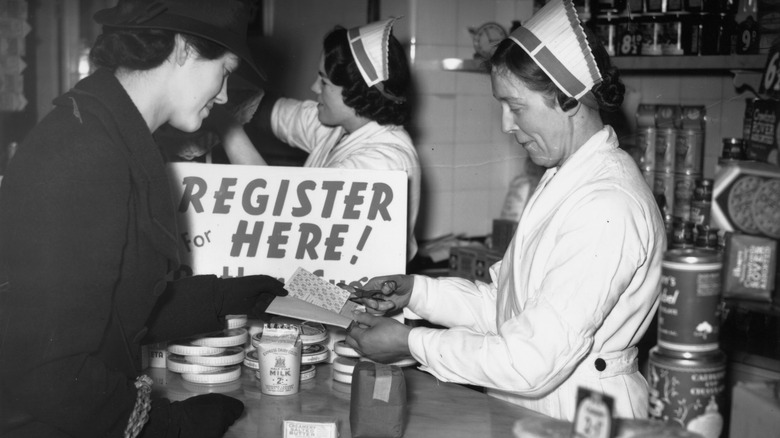How A Butter Shortage Helped Margarine's Popularity To Skyrocket
Diehard butter fans might poke fun at the "I Can't Believe it's Not Butter!" product name. If you self-identify as a card-carrying butter-lover, then there's probably a good chance that you can tell the difference between butter and margarine, thank you very much. When margarine first hit the market in 1873, it wasn't immediately popular then, either — but not because foodies didn't like it.
In case you haven't worked with it before, margarine is primarily made from vegetable or animal fats and oils. It spreads like butter, offers a similar flavor, and its comparable fat content makes it a fitting substitute for use in cooking and baking recipes. Doesn't sound all that bad, really. So why hasn't it become more popular? It might have something to do with margarine's rocky start.
Initially, margarine was marketed as a more affordable butter alternative. While this might seem like a good thing for consumers, it looked like trouble for dairy producers. In an effort to squash the new competition and turn foodies against it, U.S. dairy manufacturers teamed up to influence margarine regulation at the political level. They lobbied for strict marketing legislation on margarine, which the federal government enacted as the "anti-color" laws in 1886. In 26 states, the sale of yellow-colored margarine was illegal. In Vermont, New Hampshire, and South Dakota, margarine had to be colored pink. Sounds appetizing? 20th-century foodies didn't think so, either — at least, not at first. Here's how a butter shortage helped margarine's popularity skyrocket.
WWII rationing gave margarine a captive audience
Perhaps surprisingly, the second World War brought about some of the most memorable moments in food history. Home cooks in Italy invented a straw-lined cooking box that didn't require electricity. One navy battle used potatoes as projectiles. Believe it or not, the war also breathed new life into the failing margarine market in the U.S.
When the U.S. entered WWII in 1941, nearly 70 years after margarine's short-lived debut, one of the first foods to be subjected to strict rationing was butter. Many folks couldn't afford butter during the Great Depression of 1929-1939, but when the war hit, there wasn't enough butter to go around whether people could afford it or not. On January 30, 1942, the federal government passed the Emergency Price Control Act, which enacted nationwide rationing in an effort to curtail any resource hoarding. Suddenly, U.S. consumers could no longer rely on imported foods, and a significant portion of domestic produce was being wired to soldiers on battlefields around the world. By March 1943, home cooks needed government-issued vouchers to purchase staples like sugar, meat, cheese, canned milk, canned fish, and fats (a.k.a. butter).
Suddenly, margarine didn't sound too bad anymore — but it still looked pretty bad. In light of the grocery crisis, Congress did away with the strict margarine regulations in 1950. For an appetizing change, margarine was allowed to be colored yellow again, and its position in the grocery aisle hasn't faded since.

